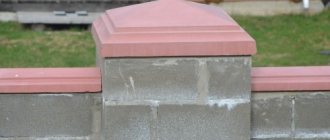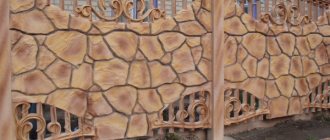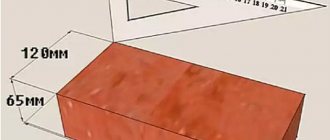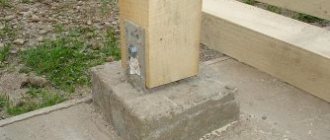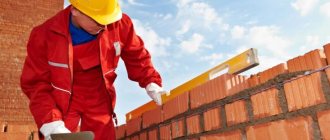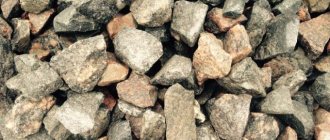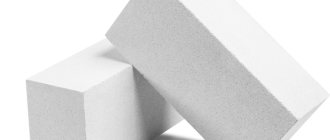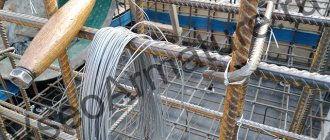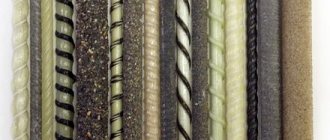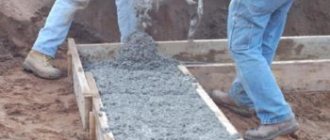Preparing for work
Unlike fences, the spans between the supports are covered with lightweight material: wood or corrugated sheeting, when building a fence made of cinder blocks, it is necessary to install a strip foundation along the entire perimeter of the site. This is a separate big job, so we have written detailed instructions for building a foundation for a fence.
After laying the foundation, they proceed directly to the masonry.
Advantages over other materials
Sand blocks used for the construction of fences
Fence blocks not only have extreme strength, but also many more advantages:
- the intake block is resistant to external factors, such as changes in temperature or pressure;
- fence blocks are not subject to rotting and are heat-resistant, such structures are durable;
- the fence block is non-toxic, as it is made from natural materials;
- hollow blocks increase sound insulation and lighten the weight of the structure;
- the block fence repels moisture;
- masonry can be done in any climatic conditions;
- facilitates and speeds up the laying of the weight, shape and size of the fence blocks.
The structures can withstand low temperatures and are moisture resistant; with these qualities they are superior to fences made of other materials.
Required Tools
To build a fence you will need:
- Concrete mixer or container (trough) for preparing masonry mortar;
- Angle grinder (grinder);
- Cutting wheel d-200 or more mm;
- Shovels: shovel and bayonet;
- Trowels;
- Kirochka;
- Chisel;
- Construction plumb line;
- Cord;
- Laser or water level l-10-20 meters;
- Construction level with a length of at least 1000 mm;
- Construction spatulas;
- Brushes and rollers.
Other varieties
Splitters. They are prefabricated structures of two halves, each of which is a large hollow brick. Structurally, they resemble formwork, only non-removable.
Sand blocks. The production technology is similar to concrete products, only the base is made from a mixture of stone crushed into sand, and then shaped and fired in a kiln.
Due to vibration when compacting the mass, a homogeneous structure without voids is obtained. Accordingly, their strength increases. The shape, size and weight can be very different, everything will depend on the manufacturer.
Glass blocks. Used alone or in combination with concrete elements. Such structures are still not very popular; they are mainly installed as partitions inside the garden.
The building blocks differ in composition. In this case, different materials can be used as filler:
- crushed stone;
- gravel;
- slag;
- broken concrete, granite, glass or brick;
- expanded clay
Cement is always the main component. It can be characterized by different brands. However, in order to increase the strength of individual products and the entire structure, it is recommended to use M400 or M500 cement. The choice of material type should be made taking into account the intended purpose of the object. For example, high-strength concrete blocks are made from M500 cement. To reduce costs, and also in cases where there is no need to build a high-strength fence, you can use products made from M200 cement.
Blocks are divided into groups:
- hollow or splitter;
- full-bodied.
In the first case, the products consist of two halves. In a ready-to-use form, they are characterized by the presence of through holes. The voids in their design make it possible to lay communications or perform reinforcement. In addition, splitter blocks weigh less, which means that installation work can be done independently. As a result, the fence construction process will take less time.
We invite you to familiarize yourself with the DIY Bottle Robot
Hollow products are presented in two options: L-shaped, symmetrical. Both varieties, when combined with the second half, make it possible to obtain a block of the correct shape with right angles. Such products can be rectangular or square. It all depends on the purpose and tasks that are planned to be solved. For example, when constructing pillars it is easier to use square blocks. However, they are not suitable for the construction of fence sections.
There are also decorative blocks for the fence. They are characterized by an attractive appearance and have different textures. This group includes a type of block called torn stone. Such products imitate natural material. The decorative block is available in two options:
- double-sided;
- unilateral.
Any of them is suitable for a fence; the choice is made taking into account the preferences of the owner of the site. For example, if you need to build a fence that will resemble a structure made of stone, it is better to use double-sided blocks. When the task is to build a fence that will be attractive from the outside, one-sided products are used.
The material may be unpainted, then the shade will remain gray. If it is necessary to build a fence of a different color, a pigment is added to the mixture before the molding process begins, which will allow you to obtain the desired shade. If desired, you can consider painting the fence. However, this method has a main drawback - loss of color over time. For this reason, the coating has to be updated. If you add pigment to the concrete mixture, the fence will retain its attractiveness for a long time.
Block laying
Depending on the size of the block (there are several standard sizes: 390x190x188 and 390x120x188 mm), the number of blocks in height is calculated. Blocks of the first standard size are quite heavy. Their weight can vary from 15 to 20 kg, depending on the number of voids in the body of the block. It is difficult to work with such blocks without an assistant. Blocks of the second standard size are one and a half times lighter and it is quite possible to handle the masonry alone.
Before starting work, prepare masonry mortar. Cement grades M200–M300 are used. The use of higher grades is impractical, since the solution, unlike the foundation, does not bear heavy loads and is not exposed to moisture.
The proportion of cement to sand is usually 1:4, but can vary from 1:2.5 to 1:8 - depending on the brand of cement. The higher the grade, the less cement is used. The water in the masonry mortar is 0.5–0.8 to 1 part of cement. The solution should be plastic, but not liquid. It should retain its shape, but not crumble when applied.
To give the solution additional strength, additives (liquid glass, plasticizers) are sometimes added to it. You should not use them when laying a fence. They will only make construction more expensive.
The layer of mortar between the blocks should not exceed 10 mm. The excess is immediately removed with a trowel; after laying out one row, the seams (along the facade) are treated with jointing to give them an aesthetic appearance.
Particular attention should be paid when working with cinder blocks that have a decorative protective layer applied. In order not to spoil the façade of the fence, excess solution is immediately washed off with a soft rag and plenty of water.
If the fence is simple - strip, the masonry is carried out in layers, laying out a number of blocks along the entire length of the side of the fence. If the fence has support points (pillars), then the pillars are laid out first. Inside, they may have a frame made of reinforcement or reinforced with a metal pipe. After laying out the pillars, the space between them is filled. The thickness of the masonry is ½ block. That is, the thickness of the fence will be 188 mm.
After completion of the masonry, the top layer of cinder blocks must be isolated from moisture by laying a layer of rolled waterproofing on top.
Tin caps are installed over the pillars, and gable roofs are installed along the fence, protecting the fence from precipitation.
How to make a cinder block fence with your own hands?
In order to build a reliable, durable fence around a plot of land, you need to choose the appropriate material. A stone wall can look very impressive, but the high price and considerable complexity of the masonry often force us to reject this idea. Brick is much easier to use, but still expensive, which means you should find a more acceptable option. A cinder block fence can be an excellent choice. Firstly, it is really strong, reliable and durable. Secondly, it is significantly cheaper than brick, and the cost of fencing (ideally) should not exceed 2–3% of the cost of the main structure. Thirdly, construction is technically simple; it does not require the involvement of highly paid qualified specialists.
Advantages and disadvantages
It is easy to see that the preference for cinder blocks for building a fence is justified. To do this, it is enough to consider the positive aspects of its use:
- the strength and reliability of the structure - it will not be toppled by a hurricane, nor will it be destroyed by precipitation, severe frost followed by a sharp thaw, or even fire;
- durability – long service life (at least half a century), no restoration required every couple of years;
- ease of execution and high speed of construction;
- It is not necessary to involve specialists - all work can be carried out independently;
- relatively light weight - the structure is 1.5 times lighter than a similar brick one and 2.5 times lighter than a stone one;
- relative cheapness;
- the possibility of giving an aesthetic appearance - the cinder block can be painted or initially chosen in color, plastered, coated, covered with tiles.
However, to make an informed decision, all features should be taken into account. Possible negative characteristics include:
- low sound insulation (if this parameter is at all justified in relation to the fence);
- hygroscopicity can be significantly reduced by laying waterproofing between the foundation and the wall, using water-repellent facing materials on vertical surfaces and a protective coating on top.
Thus, it can be stated that the advantages of cinder block allow it to be used for the construction of fences. The shortcomings are easily eliminated or are not fundamental.
Types of cinder block fences
The variety of building materials allows you to make fences that best suit your specific needs and are not similar to those of your neighbors. As an option, cladding is used to give the fence a unique appearance, but this inevitably entails additional costs. You can try using a combination of cinder block elements of different colors within one section of the fence. According to reviews, a fence made of colored cinder blocks looks very impressive, although over time, of course, it fades a little. Often there are pigmented blocks designed to look like chopped stone, designed specifically for fencing.
As a compromise option that takes into account many parameters (strength, aesthetics, cost, and so on), a combination of different materials can be used. This allows you to simulate different versions of many structural, technological and conceptual solutions in order to ultimately choose one of them, for example, to build a fence from corrugated sheets and cinder blocks. Brick columns are often used as dividers. Sections can be made of cinder block, and some elements can have a smooth front surface, while others can have a rough surface, made to look like “torn stone”.
Decorating and painting
The facade of the fence made of gray cinder blocks needs plastering and painting. To do this, you can use ready-made (industrial) dry plaster mixtures prepared in accordance with the instructions:
- Mineral;
- Silicate;
- Silicone;
- Acrylic.
You can prepare the plaster yourself. The principle of preparing plaster is the same as when preparing masonry mortar. Only the proportion changes. They take less cement, more sand, and fluff lime is added as a filler.
A layer of plaster is applied 8–10 mm thick.
For painting, water-based paints are used (acrylic, silicate, latex, silicone, etc.). Their selection is wide, and prices vary.
Painting red
Painting yellow
The paint is applied with a paint roller in 1–2 layers, depending on the base and absorption into the plaster base.
Fence made of cinder blocks
A modern fence is a combination of functionality, durability, cost, and aesthetic appearance. All these conditions can be taken into account when erecting a cinder concrete fence. This is an inexpensive, fairly durable material with excellent performance and decorative characteristics. Its laying requires a minimum of skills and can be done quickly with your own hands. Simple instructions will allow you to make fencing elements yourself, which will reduce the cost of the fence (more details about the prices of cinder blocks in this article).


